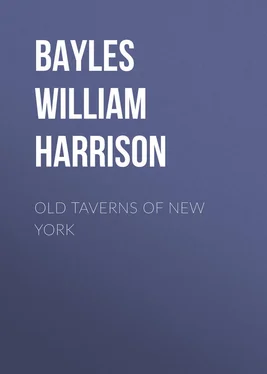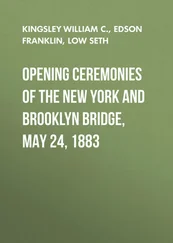William Bayles - Old Taverns of New York
Здесь есть возможность читать онлайн «William Bayles - Old Taverns of New York» — ознакомительный отрывок электронной книги совершенно бесплатно, а после прочтения отрывка купить полную версию. В некоторых случаях можно слушать аудио, скачать через торрент в формате fb2 и присутствует краткое содержание. Жанр: foreign_antique, foreign_prose, на английском языке. Описание произведения, (предисловие) а так же отзывы посетителей доступны на портале библиотеки ЛибКат.
- Название:Old Taverns of New York
- Автор:
- Жанр:
- Год:неизвестен
- ISBN:нет данных
- Рейтинг книги:3 / 5. Голосов: 1
-
Избранное:Добавить в избранное
- Отзывы:
-
Ваша оценка:
- 60
- 1
- 2
- 3
- 4
- 5
Old Taverns of New York: краткое содержание, описание и аннотация
Предлагаем к чтению аннотацию, описание, краткое содержание или предисловие (зависит от того, что написал сам автор книги «Old Taverns of New York»). Если вы не нашли необходимую информацию о книге — напишите в комментариях, мы постараемся отыскать её.
Old Taverns of New York — читать онлайн ознакомительный отрывок
Ниже представлен текст книги, разбитый по страницам. Система сохранения места последней прочитанной страницы, позволяет с удобством читать онлайн бесплатно книгу «Old Taverns of New York», без необходимости каждый раз заново искать на чём Вы остановились. Поставьте закладку, и сможете в любой момент перейти на страницу, на которой закончили чтение.
Интервал:
Закладка:
William Harrison Bayles
Old Taverns of New York
PREFACE
Much has been written about the old taverns of New York in a disconnected way, but heretofore there has been no connected story linking them with the current events of the early history of the city. This story I have attempted to tell from the Dutch settlement down to the early part of the last century, when the growth of the city and extensive travel entirely changed their character. In doing this I have found myself at issue with many writers on the subject. In every such case the conclusions set down in this book rest I believe upon unquestionable documentary evidence, in part referred to in the text.
Before any newspapers appeared the tavern was a very important institution in the community. It was the medium of all news both political and social, the one place where people of all kinds met to exchange views on every subject of interest to the general public. In this way it exercised an influence second only to the church.
The connection of the taverns with the history of the city was very close. There was hardly an event of importance but had its inception in the taverns, where all questions of interest to the public were discussed as in no other place. They were frequented by all classes and the influence of each one of them on the community depended entirely on the character of those who patronized it. The merchants, the politicians and the men of letters each had their places of rendezvous.
Following the history of the city chronologically I have endeavored to link with it the influence of the taverns on current events, and at the same time show up the interesting features of tavern life by details of happenings at these places. I have made no attempt to increase interest by any means except the plain, unvarnished truth, which I have considered sufficiently attractive. Tales of the old taverns are enhanced in interest by a glamour of antiquity surrounding the subject by which few can fail to be charmed.
Nothing exists at the present day in any way resembling an old tavern of the first class in colonial times. It was the place for political discussion, for social clubs and for meetings of all kinds. Every one went to the tavern and from no other source could a person gain so much knowledge of public affairs.
W. Harrison BaylesI
Dutch Taverns
On the return of Hendrick Hudson from his voyage of discovery in 1609, his reports were so favorable, especially, as to the abundance of valuable furs which were to be had at very little cost, that several merchants of Amsterdam, without delay, fitted out trading vessels and sent them to trade with the Indians in the territory he had visited. The returns were satisfactory, and they formed themselves into a company under the name of the United Netherland Company and established a trading post on the southern part of Manhattan Island. The exclusive privilege of trade, which had been granted them by Holland, expired in the year 1618, and they endeavored to have the grant renewed or extended, but succeeded only in obtaining a special license, expiring yearly, which they held for two or three years longer.
In the meantime a more extensive association had been formed by some merchants and capitalists of Holland, who in the year 1621 received a charter under the title of the West India Company, which gave to them the exclusive privilege of trade on the whole Atlantic coast, so far as the jurisdiction of Holland extended. Powers of government were conferred upon the company and the right to make treaties with the Indians.
In 1623, they sent out a vessel which carried thirty families to begin the colony. The vessel landed her passengers and freight near the present site of Albany and a settlement was there established. The return cargo of skins and other freight was valued at about twelve thousand dollars.
It having been determined to fix the headquarters of the company in New Netherland on Manhattan Island, two ships cleared from Holland in 1625 with a large number of settlers for this place. With these was sent out Peter Minuit, as Director-General, to superintend the interests of the company. On board the vessels were carried more than a hundred head of cattle, besides other domestic animals, such as would be needed by the people in a permanent settlement. This was the first real settlement on Manhattan Island. The few huts and storehouses, surrounded by a stockade for protection against the Indians, although it appears they were very friendly, which had been located here for many years, was not a settlement; it was only a trading post; no attempt had been made to cultivate the land.
Unlike the New England settlers and the Swedes upon the Delaware the Dutch did not make use of the log house, so well adapted by economy, ease of construction and comfort, as a temporary home. It is said that Dutch traders built huts very much like those of the Indian tribes of the neighborhood.
The Indian house or hut was made by placing in the ground two parallel rows of upright saplings adjoining each other and bringing their tops together, lapping them over each other in a curve. On this were fastened boughs and reeds, as a protection against wind and rain, the inside being lined with bark nicely joined together. If such skill were used in joining the bark on the inside as is displayed by some of the North American Indians in building their canoes, it must have presented a very neat and smooth appearance. There was no floor, the fire, in winter, being built upon the ground, the smoke escaping through an opening in the roof. The width of the house was invariably twenty feet, the length being regulated by the number of families occupying it.
If the Dutch traders used such huts they undoubtedly modified them somewhat as to fireplace and chimney and probably made many other improvements to suit their needs.
Peter Minuit, the Director-General, to obtain title to the island, purchased it from the Indian proprietors, and the settlers commenced their town by staking out a fort, under the direction of Kryn Frederick, an engineer sent out for that purpose, and set about the erection of their temporary homes, which were little better than those of their predecessors, the traders. The next year, 1626, the machinery for a saw mill arrived from Holland and a mill worked by wind power was erected on what is now Governor’s Island, which was then covered with a fine growth of forest trees, which after being cut up, could be easily floated to the little town. The settlers were thus supplied with lumber which enabled them to erect buildings more conformable to their needs. They built, as a rule, houses of only one story in height, with two rooms on the ground floor and a garret above. The roof was reed or straw thatch, and this material continued to be so used for about thirty years after the first settlement of New Amsterdam. The fireplace was built of stone to the height of about six feet, having an oven of the same material by the side of it, extending beyond the rear of the house. The chimney above the stone work was made of boards plastered inside with mortar. The average value of these houses was about one hundred and fifty dollars.
The Dutchman did not come to America for the sake of religious or political freedom or to escape persecution. He was lured by the profits of trade and the prospect of finding a better and more extensive home for himself and for his children. In the little village or town that had been formed by the first settlers on the southern point of Manhattan Island no Puritanical laws or regulations prevented him from dealing in beer or strong drink, or in drinking as much as he had a mind to. Beer was the Dutchman’s drink, and the West India Company very early erected the Company’s Brewery on the north side of Bridge Street, between the present Whitehall and Broad Streets, to supply the little town with its usual beverage.
Читать дальшеИнтервал:
Закладка:
Похожие книги на «Old Taverns of New York»
Представляем Вашему вниманию похожие книги на «Old Taverns of New York» списком для выбора. Мы отобрали схожую по названию и смыслу литературу в надежде предоставить читателям больше вариантов отыскать новые, интересные, ещё непрочитанные произведения.
Обсуждение, отзывы о книге «Old Taverns of New York» и просто собственные мнения читателей. Оставьте ваши комментарии, напишите, что Вы думаете о произведении, его смысле или главных героях. Укажите что конкретно понравилось, а что нет, и почему Вы так считаете.












